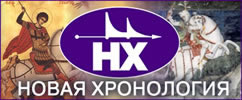|
статейка на эту тему в pdf формате: http://opensiuc.lib.siu.edu/cgi/viewcontent.cgi?article=2531&context=ocj&sei-redir=1&referer=http%3A%2F%2Fwww.google.ru%2Furl%3Fsa%3Dt%26rct%3Dj%26q%3Djonah%252Barion%26source%3Dweb%26cd%3D18%26ved%3D0CEgQFjAHOAo%26url%3Dhttp%253A%252F%252Fopensiuc.lib.siu.edu%252Fcgi%252Fviewcontent.cgi%253Farticle%253D2531%2526context%253Docj%26ei%3D3OWuTrrBKO_14QTRoIGYDw%26usg%3DAFQjCNF-sV9yR6UQ5vTXU-fPO2J4QkOHNQ#search=%22jonah%2Barion%22 The Jonah Story and Kindred Legends (Illustrated)
процитирую её сюда, с комментариями
THE ancient tradition of the fish as a guide through the ocean of death reaches a new phase in those stories which have found their classical type in the Biblical Book of Jonah. The myth assumes a literary form and thereby the properly mythological features disappear; it is humanized, but the symbolic meaning of it was still understood in the days of Christ. Being one of the latest additions to the Old Testament the story scarcely received its final shape much before the third century preceding our era.
The interpretation of the Jonah story is contained in a prophecy which Gospel tradition places in the mouth of Jesus himself, who says: "For as Jonas was three days and three nights in the whale's belly; so shall the Son of man be three days and three nights in the heart of the earth."
The interpretation of the fish as representing both the powers of death and also the chance of resurrection, or of an immortality of some kind, is unequivocally expressed in the quoted passage. We may assume that this interpretation is the echo of a very ancient tradition and actually represents the original meaning of the myth.
The Book of Jonah is apparently not derived from an Israelite source. Its Gentile origin is indicated by the fact that its scene is laid in Nineveh the "Fish City." It is the only book of the Old Testament which speaks of the salvation and conversion of a Gentile nation. It is true the hero of the story appears to be, though he is not necessarily, a Jew, but he is sent out to pagans. He is sent not to convert them to Judaism, but to make them repent of their sins.
The moralizing tendency in connection with the legend ought not surprise us, for the same tendency develops in other myths. Think only of the moral lessons which accompany the Heracles story in its later versions where the solar hero from a boisterous and sometimes even mad athlete develops into a paragon of virtue and the ideal of a cosmopolitan defender of the right.
The Jonah story is not so isolated in comparative folklore as it might appear. It is true that the versions of it in the mythology of other nations seem to have disappeared, but traces of it are still left in Greek mythology, only the dolphin replaces the monster fish.
The dolphin is sacred to such saviour gods who are restorers to life as Apollo, Eros and Dionysus.1 One Greek legend explains the connection between Dionysus and the dolphin in the story that Dionysus was once caught by Tyrrhenian pirates who were changed into dolphins and then driven into the sea by satyrs. Thenceforward the dolphin was sacred to Dionysus.
We cannot doubt that the original meaning has been obliterated in this legend which is artistically represented in the relief of the Lysicrates monument at Athens.
The best known legend of salvation through a fish is the legend of Arion. It is said that Arion the minstrel was on his way to Corinth bringing with him many precious gifts which he had gathered while abroad. The sailors coveted his treasures and wanted to kill him, but granted him his last wish to sing before he died. Then the dolphins gathered around the ship and when he jumped into the sea, one of them carried him safely to shore. Arion, however, forgot to push the dolphin back into the open water, and so the unfortunate creature died on the shore. The king of Corinth ordered a burial as if he had been a human being and placed a bronze dolphin on the tomb in commemoration of the marvelous event. When the sailors reached Corinth he summoned them to his palace and inquired after the fate of his friend Arion. They declared that he had died on the voyage and were ready to confirm the statement by oath. The king led them to the dolphin monument, but when they were ready to take the oath Arion stepped forth from the inside of the statue whereby the sailors were convicted of their crime.
спасение через рыбу - христианская символика. Арион - поэт, певец, как Орфей, Давид. Вез с собою на корабле какие-то драгоценные дары из-за границы, и моряки или пираты возжаждали заполучить его сокровища и убить его (жадный Иуда, иудеи, Пилат, римские солдаты, делящие по жребию его дорогие одежды; в то же время сокровища можно понимать и в духовном смысле; а также и как царскую власть). Его пение перед смертью, перед тем как броситься в воду, можно понимать и как его проповеди, можно вспомнить псалмы Давида, а "игру на лире" можно понимать и как боевое столкновение. Дельфин (рыба, кит) спасает его и выносит на берег, берег как символ спасения или воскресения, вознесения. Дельфин при этом остается на земле - пустая гробница? Далее выясняется, что Арион все-таки жив, он показывается изумленным свидетелям. В то же время какой-то другой царь (Орды?) изобличает преступников и, надо полагать, наказывает их. Монумент дельфину - возможно, памятник Христу. И, как пишет автор, нет сомнений, что Арион первоначально был таким же богом, как Аполлон, Эрос или Дионис.
Похищение Ариона пиратами аналогично случаю с Дионисом (и возможно, с Юлием Цезарем?): Another parallel is the myth of Dionysus and the sailors, related in the Homeric Hymns: Tyrrhenian pirates try to lash the god to the mast, but the wood itself starts to sprout and the mast is entwined with ivy (like the god's thyrsus); the sailors leap into the sea and are transformed into dolphins. This is especially interesting because Arion is credited with the invention of the dithyramb, a dionysiac song. http://en.wikipedia.org/wiki/Arion#Mythological_parallels
We can not doubt that Arion was originally a god like Apollo, like Eros or Dionysus. His minstrel character he had in common with these three gods, and that he passed unharmed through the sea on a fish's back symbolizes the soul's journey through death to new life.2 In assuming a literary shape the myth has been humanized but in a different way than the story of Jonah. There may actually have been a bronze monument erected to the sacred fish, and the poet who adapted the tale to the taste of his age made Arion ride on the back of the dolphin and afterwards come out from within the monument. We must assume that in the myth Arion traversed the sea in the belly of the fish and on arriving he came forth from the real dolphin, not from the bronze monument. The connecting link may have been the dramatic performances of the legend in which this tradition was commemorated.
Another story less known but not less significant is preserved in the legend of Melikertes. But in this case the fish rescues the body of the victim, and so we are reminded that the hero must die and did die according to the old tradition. The legend states that Ino, the sister of Semele and aunt of Dionysus, in order to escape the wrath of her husband, King Athamas, threw herself and her youngest son Melikertes into the sea from the Molurian rock. She became the local goddess of those shores, helping sailors in distress. The body of Melikertes, however, was borne by a dolphin to the isthmus of Corinth and deposited under a pine-tree. The Corinthians instituted the Isthmian games in his honor, and coins of Corinth commemorate the event.
The name Melikertes seems to indicate that this form of the legend has been imported from Phoenicia, for the name Melikertes appears to be a Hellenized form of Melkarth. This derivation is further confirmed by the existence of a Tyrian coin on which Melkarth, lord of the city of Tyre, is represented as riding on a sea horse. The Greek word Melikertes would mean honey-winner, and in Greece his name was associated with the honey cult, but it has originally as little to do with honey as Heracles with the goddess Hera. These explanations are mere afterthoughts suggested by accidental similarity of sound. One coin here inserted (the last in our illustration) indicates that Melikertes was originally a god of vegetation, because he is surrounded by ears of wheat and other symbols of vegetable life. Hans Schmidt in his scholarly book on Jona (Gottingen, Vandenhoeck & Ruprecht, 1907) points out that in the two stories of Melikertes and Arion the artistic sense of the Greek has obliterated the grotesque features of the myth which appear natural in Oriental religions but are offensive to Greek taste.
история Меликерта переплетается с историей Ино, Семелы и Диониса (о них в "Геракле", гл. 2). Меликерт с матерью скрываются от преследования злого царя (Ирода), прыгая в море, мать при этом становится богиней Левкотеей (левкос=белый), спасающей корабли и моряков от ненастий (здесь можно вспомнить истории, связанные с мысом Фиолент и Ифигенией), а Меликерт был перенесен дельфином на Коринфский (Крымский?) перешеек (опять упоминается Коринф, как и в истории с Арионом) и положен под сосну (здесь смешение событий времен детства, бегства в Египет, и распятия, когда появляется дерево-столб-крест, с которого Христос был снят и положен рядом под него Марией и сопровождающими). Дельфин тогда играет символическую роль как и в случае с Арионом. И в честь этого события были учреждены Истмийские игры (как и Олимпийские игры в честь Христа) и отчеканены монеты. Имя Меликерта напоминает имя финикийского героя Мелькарта, царя Тира, который на монетах изображался скачущим на морском коне. (Мелькарт по-финикийски якобы значит "царь города", малик - царь, карт (гард-град-крат) - город или орда?; не знаю, имеет ли сюда отношение арабское ард, еврейское эрец). В то же время греки прочитывали имя Меликерт как honey-eater (другие варианты: honey-cutter, honey-winner), т. е. поедатель меда или что-то аналогичное, мели по-гречески мёд. (Уж не медведь ли получается? Медведь - герб Ярославля). В то же время Меликерт был первоначально богом растительности, его изображение на монетах окружалось колосьями пшеницы и другими растительными символами.
The story of salvation through the fish must have been very popular, for it was told and retold and changed in different versions. Hellanikos in an incidental comment (apud. Schol. Iliad Y. 146) relates that Heracles in delivering Hesione, the daughter of King Laomedon of Troy, descended into the belly of a dragon and slew him by cutting his intestines, which was a task of three days' labor. The monster was of such a nature as to burn the hero's hair by the internal heat of his body.
Гелланик рассказывает историю о том, как Геракл, спасая дочь троянского царя Лаомедона Гесиону (океанида, ставшая женой Прометея, по Акусилаю и Эсхилу http://en.wikipedia.org/wiki/Hesione ), забрался в брюхо дракона и зарезал его изнутри, что заняло у него целых три дня трудов (Иона во чреве кита тоже был три дня и три ночи). Но внутренний жар монстра сжег Гераклу волосы (намек на костер-крест или терновый венец?). Подвиг, сближающий Геракла с Персеем, св. Георгием и другими аналогичными героями.
This adventure is quite isolated and is not enumerated among the twelve labors of Heracles; yet it finds another parallel in the story of Jason not mentioned in the legend, but repeatedly represented in art. There is a vase picture which shows Jason coming out of a dragon's jaws in a fainting condition. Before him stands Athene assisting the hero in the accomplishment of his feat. Happily Jason is identified by an inscription and Athene by the medusa head on her breast and an owl which she holds in her left hand. Otherwise in the absence of all information in Greek literature we would be at a loss what to make of the picture. Nor is this motive
in ancient art isolated, for an Etruscan metal mirror pictures Jason, who is identified by an inscription, sword in hand as being swallowed by a snake-like monster.
похожая история есть и с участием Ясона, история не отмеченная в легенде, но изображаемая в искусстве, на вазах (см. иллюстрацию): Ясон выходящий (условное слово) из челюстей дракона, морского чудовища в обморочном состоянии (=снятие с креста?), заметьте, на заднем плане изображено дерево, с висящем на нем в таком же повисшем состоянии золотым руном (символ овна, агнца божьего, повешенного на древе-кресте?), рядом Афина с копьем (в христианской сцене копье - атрибут сотника Лонгина и римских солдат), узнаваемая по изображению медузы Горгоны на ее груди и сове в ее руке (возможно это$не сова, а голубь, символ св. духа?). Афина напоминает здесь саму Марию при крестных страданиях Христа. Кстати орнамент по периметру содержит кресты.
The Jonah story differs from the myth of Heracles in so far as the fish has changed into a monster which must be struggled against and conquered. The fish as a saviour changes into the power of death from which man's life must be rescued. This appears not only in the stories of Heracles and Jason but also in their variant, the story of Perseus and the rescue of Andromeda, which is most dramatically represented on a hydria, a water jar preserved in the Berlin Museum. We see Andromeda tied to a rock; to the right and to the left are her parents, and underneath in the water, which is indicated by the presence of fish, Perseus with a sickle sword in his right hand and a lance in the left struggles with the monster.
мы видим некую трансформацию образа рыбы в историях Ионы, Геракла, Ясона и других героев. Подчеркивается то мотив спасения героя и чудесного избавления (воскресения), либо момент схватки и победы над неким монстром (большой рыбой, драконом, морским змеем и т. п.).
Кстати по мнению писателя Германа Мелвилла (см. Герман Мелвилл. "Моби Дик, или Белый кит" http://www.lib.ru/INPROZ/MELWILL/mobidik.txt главы 82, 83), дракон св. Георгия был китом, т. е. рыбой, морским чудищем, т. к. "старинные книги постоянно смешивают китов и драконов и часто пользуются одним названием вместо другого. "Ты как лев на водах и как дракон в морях" - говорит Иезекииль, явно подразумевая при этом кита, а некоторые версии текста прямо употребляют самое это слово."
dragon
early 13c., from O.Fr. dragon, from L. draconem (nom. draco) "huge serpent, dragon," from Gk. drakon (gen. drakontos) "serpent, giant seafish," apparently from drak-, strong aorist stem of derkesthai "to see clearly," from PIE *derk- "to see." Perhaps the lit. sense is "the one with the (deadly) glance." The young are dragonets (14c.). Obsolete drake "dragon" is an older borrowing of the same word. Used in the Bible to translate Heb. tannin "a great sea-monster," and tan, a desert mammal now believed to be the jackal. (etymoline.com)
из вики http://ru.wikipedia.org/wiki/Дракон :
Слово «дракон» используется в именованиях некоторых реальных видов позвоночных, преимущественно рептилий и рыб.
Дракон как одно из наиболее распространённых мифологических существ — это существо, состоящее из туловища пресмыкающегося, иногда в сочетании с частями тела других животных, птиц, рыб.
В большинстве культур образ дракона связан с культом водоёмов, что связано с искусственным орошением как основой хозяйства этих государств.
Сражение с драконом — это инициационная мистерия с символикой временной смерти и возрождения.
змей требует или крадёт непорочных дев (ищет себе невесту). Требование девственности невесты
Помимо фаллической символики вытянутого змея есть символика дерева, которая нередко вплетается в сюжет змееборчества, если он встроен в общий миф. Змей-дракон изображается обвившимся вокруг дерева, или находящимся у корней мирового древа, или в его ветвях, или несёт в себе его атрибуты (образ пернатого змея на дереве, в котором соединились птица и змея, отмечающие верх и низ мирового дерева)
как видите, связь с водой (рыбой), также здесь же связь с деревом и символикой смерти и возрождения и плюс история с женщиной, с похищением дев, девы.
The rescue of Andromeda was a favorite subject with Greek artists, and our frontispiece shows one of the most beautiful marble reliefs that have come down to us from Greek antiquity.
We know nothing more about these legends, but the indication is sufficient to prove that there were myths current among the Greeks after the pattern of the Jonah story.
It is peculiar that Hellanikos makes Heracles stay three days in the belly of the monster, and this is the same time attributed to Jonah by Jesus and to his own sojourn in the "heart of the earth," which means the abode of death.3
While the Jewish prophet plays the part of a patient sufferer, being swallowed and spit out again, the Greek heroes enter the dragon's jaws not in passive submission, but with sword in hand as energetic fighters, determined to conquer the monster and gain their salvation not through prayer by the mercy of God, but through their own valor.
в разных версиях спасение или победа достигаются либо терпением, смирением и в общем пассивно (более христианский взгляд), либо с мечом в руках, энергичной борьбой, скорее собственной доблестью, чем молитвой к богу.
Though nothing can be positively stated it does not seem probable that the biblical story of Jonah has been derived from a Greek source, and if we consider that it has been located in Nineveh, the great Assyrian metropolis, we may assume with great plausibility that we shall have to seek the immediate source of the story in Assyria, perhaps through a Babylonian medium. That we have not yet been able to trace the original in the ancient monuments is no refutation. At any rate there is no reason to seek its source in a more distant country, as for instance India, where Pischel locates it. Whether or not this hypothesis be correct, it stands to reason that ultimately all the legends of the fish representing death with the power to save date back to a prehistoric source in which animal symbolism was an essential feature of religion.
We may mention in this connection that the idea of magicians living in the belly of a fish occurs also in other quarters of the world, but the similarity of this idea to the Jonah story is only in appearance. Mr. Albert Niblack publishes an interesting report about the Haida Indians in an article which appeared in the Report of the U. S. National Museum, 1888, p. 231, under the title "The Coast Indians of Southern Alaska and Northern British Columbia." There a medicine man is mentioned who inhabits a big fish, and the adjoined picture shows this soi-disant Haida Jonah in the belly of an orca. He is a kind of Indian werwohf called skana, for it is stated that he can change his shape into any animal, but his common lodging is an orca or whale. Mr. Niblack (pp. 322-323) quotes Judge Swan as saying:
"He can change into any desired form, and many are the legends about him. One which was related to me was that ages ago the Indians were out seal-hunting. The weather was calm and the sea smooth. One of these killers, or black-fish, a species of porpoise, kept alongside of a canoe, and the young men amused themselves by throwing stones from the canoe ballast and hitting the fin of the killer. After some pretty hard blows from these rocks the creature made for the shore, where it grounded on the beach. Soon a smoke was seen, and their curiosity prompted them to ascertain the cause, but when they reached the shore they discovered, to their surprise, that it was a large canoe, and not a Skana that was on the beach, and that a man was on shore cooking some food. He asked them why they threw stones at his canoe. 'You have broken it,' he said, 'and now go into the woods and get some cedar withes and mend it' They did so, and when they had finished the man said, 'Turn your backs to the water and cover your heads with your skin blankets, and don't you look till I call you.' They did so, and heard the canoe grate on the beach as it was hauled down into the surf. Then the man said, 'Look, now.' They looked, and saw the canoe just going over the first breaker and the man sitting in the stern; but when it came to the second breaker it went under and presently came up outside of the breakers a killer and not a canoe, and the man or demon was in its belly. This allegory is common among ell the tribes on the northwest coast, and even with the interior tribes with whom the salmon takes the place of the orca, which never ascends the fresh-water rivers. The Chilkat and other tribes of Alaska carve figures of salmon, inside of which is the full figure of a nude Indian. . . .Casual observers, without inquiry, will at once pronounce it to be Jonah in the fish's belly, but the allegory is of ancient origin, far antedating the advent of the white man or the teachings of the missionary."
Mr. Niblack expressly states that we have here no echo on the biblical Jonah story because the legend antedates the appearance of the white people. We might add that in other respects too the story bears no resemblance to the tale of Jonah or any of its kindred versions. The similarity is only in the appearance of the picture, which is quite incidental, but back of it there is after all a connection between the two through the aboriginal belief in the magic power of the fish, who among the Haida is identified with a great medicine man inhabiting the ocean and regarded by the Indians with great awe.
оказывается у народа Хайда (северо-западное побережье Америки; кстати на флаге у них двуглав. орёл? http://en.wikipedia.org/wiki/Haida_people ) существует похожая легенда о том, как некий шаман/знахарь очутился в брюхе касатки/кита (есть также изображения с лососем), так называемый Иона Хайда, к которому они относятся с большим благоговением.
примечания к статье:
1 Athene too is occasionally pictured as carrying a dolphin on her shield in place of the Medusa head. For an instance see a vase among the Athenean prize vessels in Springer's Kunstgeschichte, I, 102.
2 Hermes lulled Argus to sleep by his music, and the same figure of a divinity of death is represented by the piper of Hamlin. The sirens too sing, and so also does the siren of the Rhine, the Lorelei.
For further particulars with regard to the dolphin coins (on the opposite page) see Usener, pp. 278-279. It will be noted that three out of the four Corinthian coins (10-13) picture Melikertes as alive riding on the dolphin in an upright position.
1. Bronze medallion of Maximinus from Anchialus: Aphrodite in upright position and at her left Eros on the dolphin.
2. Bronze of Antoninus Pius from Nicomedia: Eros turning the dolphin to the right.
3. Bronze of Elagabal from Perinthus: Eros reining in the dolphin to the right.
4. Bronze of Gordian from Perinthus: Eros riding the dolphin towards the left.
5. An amber from Cyzicus: A man of the Tarentine type riding towards the left and holding in his right hand a tunny; below him another tunny.
6. Another amber from Cyzicus: A fully dressed woman riding on a dolphin towards the left with a wreath in her right hand and a shield in her left; below a tunny.
7. Bronze of the first century B.C., from Methymna in Lesbos: A man, clothed, sitting on a dolphin with his legs hanging down in front ; in his left hand a lyre.
8. Bronze of Commodus from Methymna in Lesbos: A man, clothed, riding towards the left on a dolphin and turning backwards; in his left hand a lyre.
9. Bronze from lassus in Caria: A youth with left arm thrown over a dolphin swimming toward the right.
10. Corinthian bronze of Marcus Aurelius: Melikertes stretched out dead on the swimming dolphin; behind him the sacred pine.
11. Corinthian bronze of Antoninus Pius: Melikertes standing upright with a mantle falling over his back, the dolphin facing toward the right.
12. Corinthian bronze of Lucius Verus: Melikertes as youth riding on a dolphin.
13. Corinthian bronze from the time of Tiberius: Melikertes as a child holding a thyrsus staff over his shoulder.
14. Silver coin of Ambracia: Athene-head with helmet; at her left a winged Eros sitting on a dolphin clasping his left knee with his hands.
15. Silver coin of Tarentum: A dolphin rider with a polypus in his left hand.
16. Silver coin of Tarentum: A dolphin rider facing the left; a mussel below.
17. Silver coin of Tarentum: A dolphin rider with inscription.
18. Silver coin of Tarentum: A dolphin rider facing the spectator and spearing a fish with a trident.
19. Silver coin of Tarentum: A dolphin rider holding a trident in the right hand and a round shield in the left.
20. Silver coin of Tarentum: A dolphin rider kneeling on his right knee and with spear and shield in his left hand.
21. Bronze coin of Brundisium: A dolphin rider with a cornucopia in his left hand, and a Victory standing on his right hand.
22. Bronze coin from Paestum: Eros riding on a dolphin holding in his right hand a wreath and in his left an upraised trident.
3 For an explanation of the number three, three and a half, after three days, etc., see the author's article "The Number π in Christian Prophecy," published in The Monist, Vol. XVI, p. 415.
иллюстрации к статье:
<""| > >
<""| > >
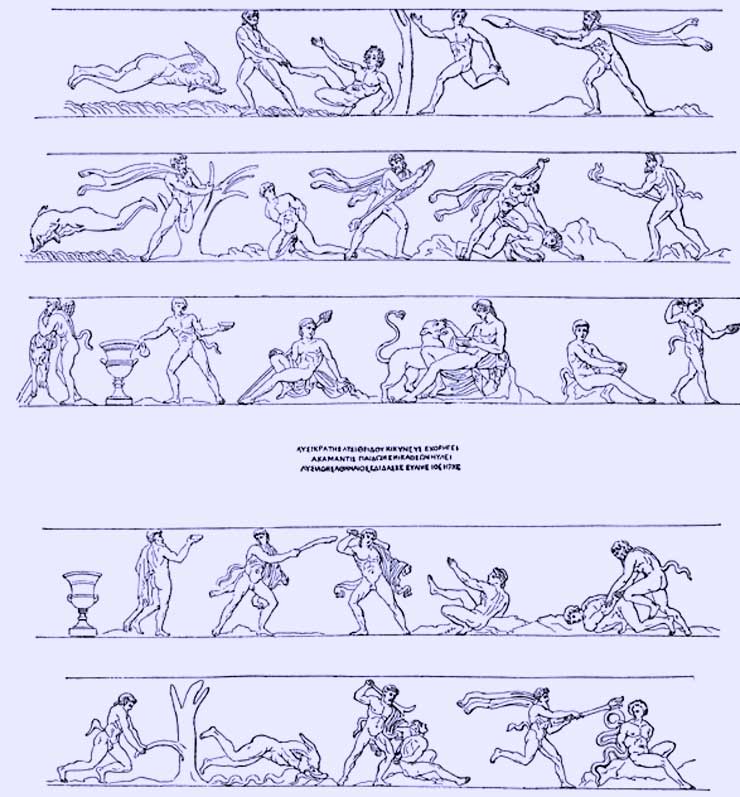 Dionysus relief, Lysicrates Monument, Athens Dionysus relief, Lysicrates Monument, Athens
<""|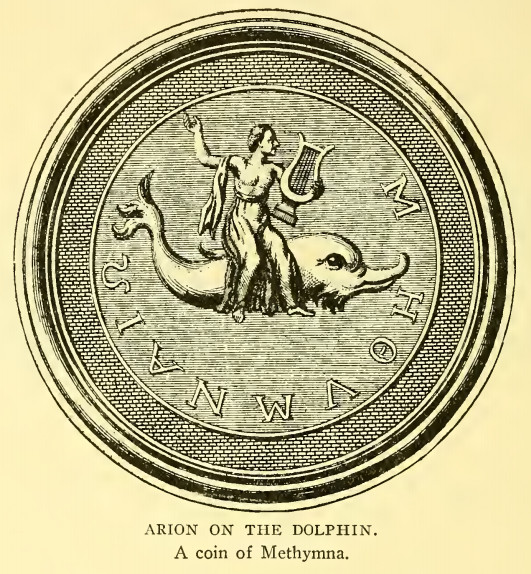 > >
<""|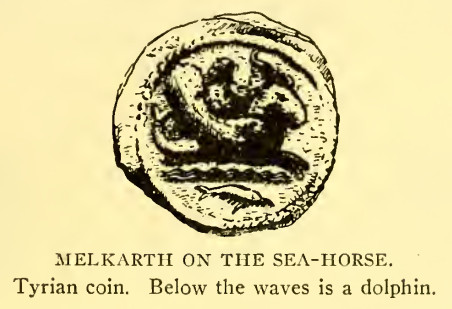 > >
<""| > >
<""|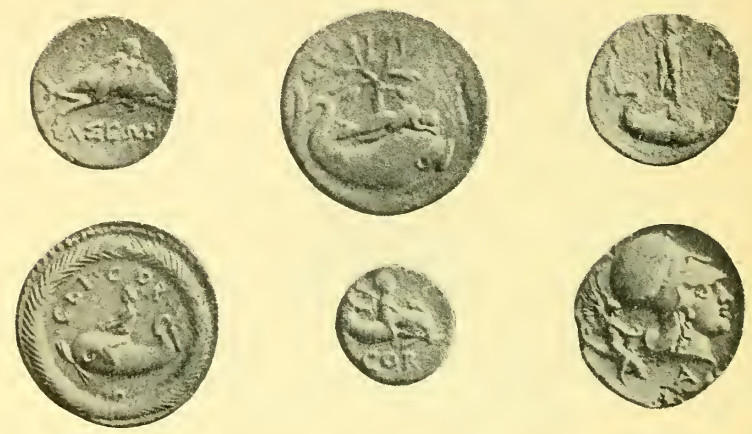 > >
<""| > >
<""| > >
<""| > >
<""| > >
<""| > >
<""| >Ясон, проглатываемый змеем на фоне дерева - аллегория крестных страданий? >Ясон, проглатываемый змеем на фоне дерева - аллегория крестных страданий?
<""| >Персей, сражающийся с большой рыбой. Кстати меч у Персея странной формы, как будто бы двойной (зульфикар?). Не есть ли картина в целом - олицетворение крестных страданий, победы над смертью, над дьяволом? Прикованная, распятая Андромеда (Андроник?) или же Кассиопея, жена Цефея (Китая?), как известно, красавица Кассиопея похвасталась своей красотой перед нереидами, морскими нимфами, чем обидела их (похоже на историю с Парисом и красавицей Еленой или Афродитой-Венерой). Чтобы искупить вину, пришлось приковать Андромеду (Андроника?) к скале, отдав её на съедение чудовищу (смерти-сатане, которых он же победил?). Верхний ряд по сути как троица (в более земном смысле, отец-мать-дитя) >Персей, сражающийся с большой рыбой. Кстати меч у Персея странной формы, как будто бы двойной (зульфикар?). Не есть ли картина в целом - олицетворение крестных страданий, победы над смертью, над дьяволом? Прикованная, распятая Андромеда (Андроник?) или же Кассиопея, жена Цефея (Китая?), как известно, красавица Кассиопея похвасталась своей красотой перед нереидами, морскими нимфами, чем обидела их (похоже на историю с Парисом и красавицей Еленой или Афродитой-Венерой). Чтобы искупить вину, пришлось приковать Андромеду (Андроника?) к скале, отдав её на съедение чудовищу (смерти-сатане, которых он же победил?). Верхний ряд по сути как троица (в более земном смысле, отец-мать-дитя)
<""| > >
<""| > >
<""|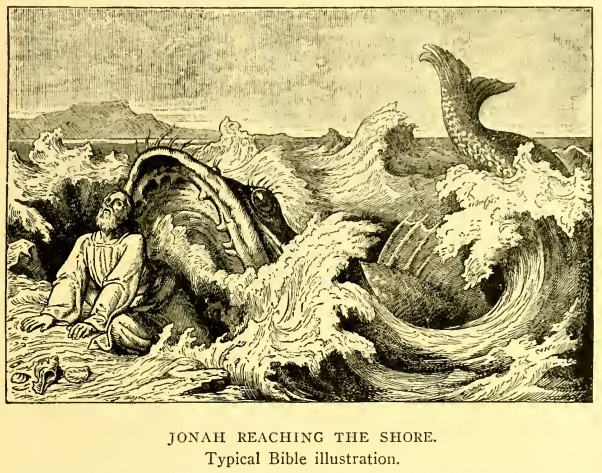 > >
<""| > >
по мнению И. Флавия, история Ионы происходила в Черном море:
http://bible.cc/jonah/2-10.htm Jonah 2:10 Then the LORD ordered the fish to spit Jonah out onto the beach.
Josephus says it was upon the shore of the Euxine sea... Huetius and others think it probable that this case of Jonah gave rise to the story of Arion, who was cast into the sea by the mariners, took up by a dolphin, and carried to Corinth. Jonah's deliverance was a type of our Lord's resurrection from the dead on the third day, Matthew 12:40
само название Ниневии, в которую ходил Иона, по некоторым мнениям, связано с рыбой:
http://en.wikipedia.org/wiki/Nineveh
The origin of the name Nineveh is obscure. Possibly it meant originally the seat of Ishtar, since Nina was one of the Babylonian names of that goddess. The ideogram means "house or place of fish," and was perhaps due to popular etymology (comp. Aramaic "nuna," denoting "fish").
возможно, Ниневия (=Троя-Константинопль-Иерусалим) и есть рыба, которая заглатывала праведников. Другая возможная дислокация для Ниневии (новой) это Новгород-Ярославль. Возможна ли связь с Иисусом Навином?
в конце истории Ионы тоже появляется дерево, вначале защищающее от солнца (гефсим. сад?), а затем засохшее, в результате чего голову Ионы так опалило, что он просил смерти у бога (крестн. страдания?), в итоге бог встал на сторону Ниневии, разрушение которой предсказывал Иона (под таким ракурсом напоминает историю в скепт. духе)
Таким образом, схожесть и переплетение всех этих историй вызывает предположение, что речь в них идет по сути об одном и том же сюжете. Кандидаты на сходство, во всяком случае, частичное: Иона, Арион, Меликерт (Мелькарт), Геракл, Ясон, Персей, (св. Георгий?), Христос. (У них даже имена почему-то попарно схожи: Иона-Арион, Меликерт-Мелькарт, Георгий-Геркулий, Персей-Парис, Ясон-Исус, Андромеда-Андроник-Адам).
|


